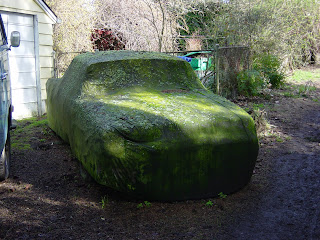Portland, Oregon: The month of May has recently adjourned after setting a record of one hundred and forty-five consecutive days of rain, smashing the previous single-month record of eighty-nine days in 1876 (“Dead Man’s April”). Portlanders woke up last week to the news that a woman who had jumped from a tall building fell directly on another woman on the sidewalk, killing both instantly. Slouching in coffee shops, languidly stroking the ridged scars on their wrists, they pondered, in that crescent of time between the last coffee and the first beer, which of the two women was the most fortunate.

Although suicide pacts among the young have largely been thwarted by lethargy, pedestrians have been observed to linger on bridges. In the animal world, cats are irritable, slugs exhibit zip, and the baby bird population has proven susceptible to drowning, with natural selection now favoring the picky eater.
In those few areas experiencing sunbreaks, rods and cones have snapped audibly; temporary blindness is reported to have led to a spike in fatal car wrecks, some of which have been ruled accidental. Elsewhere, sporadic sunbreaks have been blamed for the socially corrosive introduction of hope.


Sociologists are also studying the possible detriment to the spirit arising from Portlanders’ self-satisfaction as environmental advocates, noting that the reputation is largely unearned. Anyone willing to wait a couple years can boast a green roof, they point out, although green vehicles take a little longer.
As always, natives spurn the personal use of umbrellas, which merely add to the number of items that require drying out. These are observed only in the days leading up to the Rose Festival to protect hybrid tea roses in competition. Portland is, in fact, known as the Rose City, an umbrella term (as it were) encompassing many individual Black Spot Fungus neighborhoods, and this holds the key to understanding springtime weather patterns in the area.

Traditionally, the Rose Festival concludes with a week of parades in June, beginning with the Starlight Parade, an evening event named after a mythical sky phenomenon. This parade always features a clown troupe called the Rainmakers, who carry inside-out umbrellas and spray spectators with water pistols, an activity that was finally abandoned when nobody noticed. The Grand Floral Parade is held one week later, with thousands of plastic-covered spectators lining the streets to witness the annual drenching of delicate petals and princess curls. It’s a festive scene, and marks the coming of the sunny season, which begins the next day. Meteorologists explain that our prevailing weather pattern arises when a deep plume of moisture embedded in a powerful jet stream stretching from Japan to the Oregon coast collides with the Rose Festival Grand Floral Parade.

The hail, on the other hand, is thought to be caused by the planting of peonies.

Maybe I'll move there. At least then I wouldn't have to suffer the humiliation of wrestling myself into a swimsuit in order to take my children to the pool.
🙂 I'm a rain-hardened native, and even I am beginning to grump. Enough already!
So weird: lots of sun and heat here in the east. I am surprised by your statement about umbrellas. When we were in Vancouver it seemed that folk just got their brollies out and proceeded with business as usual, the way we handle winter over thisaway.
It is very beautiful there in the rain forest but I would go mad.
My brother in Scappoose rarely complains about the rain, since it's such a normal occurrence. But this year has been too much. Our phone conversations always begin with expletives about the continuing rain.
This is making me laugh because it's my fourth year of living here and this may be the first year I have hardly minded the rain–I didn't actually know that this was unusually wet! Seemed totally normal to me. I guess I've adapted.
Also I remember on a visit to Portland many years ago being entranced at all the moss in the Japanese garden and telling you how hard they must have worked to "cultivate" it! Ha! (East Coast: put moss in blender with buttermilk. Blend. Spread over area to be "cultivated". Keep moist. Portland: Do nothing. Wait a week. Ta-da!)
Thanks Murr. Nobody can make me laugh like you.
Ah, Anvilcloud, but that is Vancouver! Entirely different state. By the way, the shorts + socks + sandals phenomenon is also explained by the weather. Legs dry out faster than pants.
Why is Elizabeth giving us a recipe for a moss milkshake?
That one sort-a sunny day we had last week, remember that one? Well I got all encouraged and took a rack of pork ribs out of the freezer to thaw. But after two successive days of rain I had committed myself to BBQ-ing those damn ribs.
So in the pouring rain I initiated the official BBQ season. The ribs were great with me juggling an umbrella in one hand and BBQ tongs in the other.
By the way, I am assuming the "fun center" down on the waterfront is a mess-o-mud again this year?!
Robert, they had so much fun down at the fun center they had to close it down. The Ferris wheel was sinking. Suburban Correspondent, don't knock it! Dinner at Elizabeth's is always delicious, although I'd stay away from the Mold Flan.
I never knew that about peonies. I learn something new every time I pass by this way.
And a moss milshake doesn't hold a candle to a good mold fruitcake.
My Ex just got a job in Portland so my daughter is going up there to spend time with him for part of the summer. She's a little worried about the rain thing. I told her to just pretend she was a character in Twilight.
I didn't know that in 1876 the month of April had 89 days. Wow!
The strawberries (local) I just bought would make a good contribution to a mold-something.
Barb: 89 RAINY days, at that. I'm Jane, that is excellent advice. The secret of Portland, though, is we generally have four months of weather so perfect that anyone would want to live here. Should start any day now.
And Charlie, consider me your source for previously undisclosed Scienterrific Fax.
Quit hogging all the rain and send some east — we're parched!
And to think I was just beating myself up for leaving the sprinkler on in the garden for two hours… Thank goodness I didn't plant any peonies.
We moved here in November of '98 and didn't think to get blinds for my home office until May 3rd. That was the first time I realized my office faces East. The alien star had suddenly made my computer screen unreadable.
Love the car!
Your turn – last June and July in Maine was almost a total washout. Even the moose has moss.
Jon
Regarding the miserable weather, I agree totally with the last photo!
I'm a California weather weenie. I'd never make it in Portland.
Damn inconsiderate of that suicidal woman to crash land on an innocent pedestrian. She could have at least yelled, "Fore!" as she leaped.
We have had three consecutive days of rain, garnering almost two inches, and people are already jumping off garden sheds here in southern Ohio. We are celebrating because we don't have to water the frickin' tomatoes every morning. I would very quickly lose my mind and join the tall building contingent if I lived in socky Birkenstocky land. Good thing your default mode is happy, Murre.
I am writing to tell Elizabeth that I was just given a recipe for a moss milkshake that uses beer instead of buttermilk. This happened at Sterling Service Store where I get my car fixed, in a lively conversation over the counter.
xoxojz
"and the baby bird population has proven susceptible to drowning, with natural selection now favoring the picky eater."
Priceless.
Damn right, priceless. I should charge.
Damn right, priceless. I should charge.
We have had three consecutive days of rain, garnering almost two inches, and people are already jumping off garden sheds here in southern Ohio. We are celebrating because we don't have to water the frickin' tomatoes every morning. I would very quickly lose my mind and join the tall building contingent if I lived in socky Birkenstocky land. Good thing your default mode is happy, Murre.
I am writing to tell Elizabeth that I was just given a recipe for a moss milkshake that uses beer instead of buttermilk. This happened at Sterling Service Store where I get my car fixed, in a lively conversation over the counter.
xoxojz
Regarding the miserable weather, I agree totally with the last photo!
We moved here in November of '98 and didn't think to get blinds for my home office until May 3rd. That was the first time I realized my office faces East. The alien star had suddenly made my computer screen unreadable.
Love the car!
Thanks Murr. Nobody can make me laugh like you.
My brother in Scappoose rarely complains about the rain, since it's such a normal occurrence. But this year has been too much. Our phone conversations always begin with expletives about the continuing rain.
So weird: lots of sun and heat here in the east. I am surprised by your statement about umbrellas. When we were in Vancouver it seemed that folk just got their brollies out and proceeded with business as usual, the way we handle winter over thisaway.